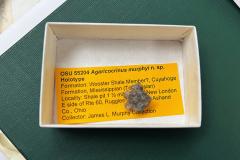Tucked away in a tiny box at the base of the Orton Hall bell tower sits a fossil no larger than a quarter. A small, yellow slip of paper that accompanies it identifies it as part of the James L. Murphy collection. The paper details other information about the specimen, including its location of origin (the Wooster Shale) and the era of formation (Mississippian, a period between 358.9 and 298.9 million years ago). One may also notice the fossil’s name, an homage to that of its finder: Agaricocrinus murphyi. The name is a fitting tribute to the collector who discovered the species, which was previously unknown to science.
James L. Murphy, or “Jim” as he was known to family, friends and colleagues, worked for University Libraries for 24 years, first as the science cataloger and then as the coordinator of the western languages section. An avid archaeologist, he held a Master of Science degree in geology from Case Western Reserve University and was the recipient of a lifetime achievement award from the Archaeologist Society of Ohio. Throughout his time as an employee of University Libraries, Murphy donated countless fossils to the Orton Geological Museum at Ohio State.
“Jim was a true renaissance man,” said Dale Gnidovec, current curator of the Orton Geology Museum. “He had extensive knowledge of Ohio geology and fossils. The fossils he donated to us probably form one of the best collections of Mississippian fossils in the country, largely because he was so good about recording such things as stratigraphy (at what level in the rock layers the fossils were collected) and locality. There is a wealth of information in the collection for future researchers.”
The Agaricocrinus murphyi fossil was just one of many donated by the devoted collector, but it may be the most significant find of his career. Bill Ausich, professor emeritus in the School of Earth Sciences, and Mark Wilson, a faculty member at the College of Wooster, identified the tiny fossil as a previously undiscovered species of crinoid.
A class of living organisms closely related to starfish, crinoids are marine animals that attach to the sea floor via a stalk. The ancient animals appeared in the fossil record approximately 300 million years before dinosaurs and exist today as what many refer to as “sea lilies.” While crinoids were once prolific in shallow-water ocean habitats, most living species now exist inconspicuously in deep water or are nocturnal in shallow water, making them much harder to spot.
“Ours is a study of crinoids from the Wooster Shale,” explained Ausich. “The Wooster Shale is 350 million years old. It’s just one of the many rock layers in Ohio, but it has a fairly decent marine fauna.”
“Agaricocrinus murphyi represents the first time this genus has been found in Ohio, and it’s in an atypical rock formation for that genus,” continued Ausich. “It’s very interesting evolutionarily and ecologically.”
Agaricocrinus murphyi is one of five previously unknown species of crinoids that Ausich and Wilson identified. Their paper about the new species aims to fill in existing knowledge gaps about the evolutionary and paleoecological timeline.
“The Mississippian is the age of the crinoid, when they reached their maximum biodiversity in the history of life,” said Ausich. “We know a lot about the Mississippian, but here we have all these new species. It helps to fill out the whole spectrum of understanding of their evolution, their lives in different environments, things like that. To me, it’s very significant.”
“Mississippian crinoids can essentially be broken down into groups of specialists and generalists based on their behavior,” he continued. “The generalists tend to have longer species ranges in time, while the specialists had shorter species durations. These new fossils are from the specialists, so they totally match our prediction that the specialists were evolving more rapidly than the other groups were and help fill in the gaps that we had. It helps with these large-scale perspectives, something that Jim probably never thought of when he collected his fossils, but we can now put them into the larger evolutionary and ecological context.”
Murphy passed away in October 2012 after a long battle with cancer. He is remembered by Libraries colleagues as enthusiastic, witty and funny, and thanks to his contributions to the Orton Geological Museum, he will also be remembered by the scientific community as a dedicated collector who discovered a new species.
Ausich and Wilson’s article is now available to read online on the Cambridge University Press website. You can also read about another crinoid species Ausich and Wilson identified on The College of Wooster’s website.


